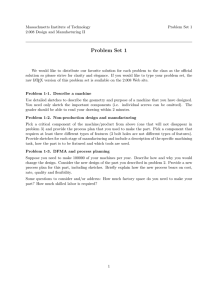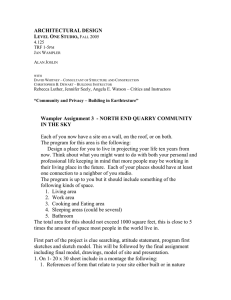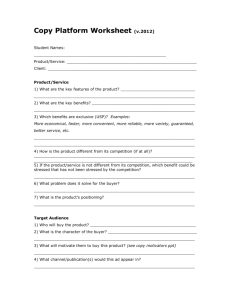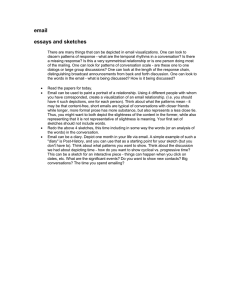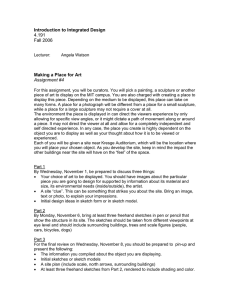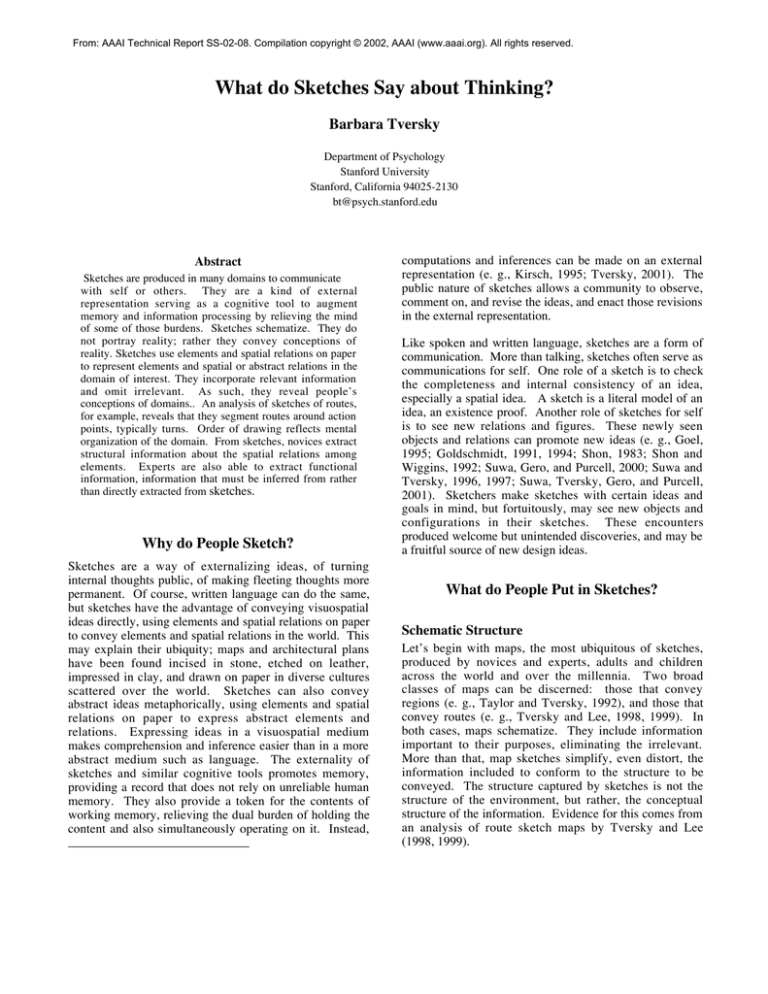
From: AAAI Technical Report SS-02-08. Compilation copyright © 2002, AAAI (www.aaai.org). All rights reserved.
What do Sketches Say about Thinking?
Barbara Tversky
Department of Psychology
Stanford University
Stanford, California 94025-2130
bt@psych.stanford.edu
Abstract
Sketches are produced in many domains to communicate
with self or others. They are a kind of external
representation serving as a cognitive tool to augment
memory and information processing by relieving the mind
of some of those burdens. Sketches schematize. They do
not portray reality; rather they convey conceptions of
reality. Sketches use elements and spatial relations on paper
to represent elements and spatial or abstract relations in the
domain of interest. They incorporate relevant information
and omit irrelevant. As such, they reveal people’s
conceptions of domains.. An analysis of sketches of routes,
for example, reveals that they segment routes around action
points, typically turns. Order of drawing reflects mental
organization of the domain. From sketches, novices extract
structural information about the spatial relations among
elements. Experts are also able to extract functional
information, information that must be inferred from rather
than directly extracted from sketches.
Why do People Sketch?
Sketches are a way of externalizing ideas, of turning
internal thoughts public, of making fleeting thoughts more
permanent. Of course, written language can do the same,
but sketches have the advantage of conveying visuospatial
ideas directly, using elements and spatial relations on paper
to convey elements and spatial relations in the world. This
may explain their ubiquity; maps and architectural plans
have been found incised in stone, etched on leather,
impressed in clay, and drawn on paper in diverse cultures
scattered over the world. Sketches can also convey
abstract ideas metaphorically, using elements and spatial
relations on paper to express abstract elements and
relations. Expressing ideas in a visuospatial medium
makes comprehension and inference easier than in a more
abstract medium such as language. The externality of
sketches and similar cognitive tools promotes memory,
providing a record that does not rely on unreliable human
memory. They also provide a token for the contents of
working memory, relieving the dual burden of holding the
content and also simultaneously operating on it. Instead,
computations and inferences can be made on an external
representation (e. g., Kirsch, 1995; Tversky, 2001). The
public nature of sketches allows a community to observe,
comment on, and revise the ideas, and enact those revisions
in the external representation.
Like spoken and written language, sketches are a form of
communication. More than talking, sketches often serve as
communications for self. One role of a sketch is to check
the completeness and internal consistency of an idea,
especially a spatial idea. A sketch is a literal model of an
idea, an existence proof. Another role of sketches for self
is to see new relations and figures. These newly seen
objects and relations can promote new ideas (e. g., Goel,
1995; Goldschmidt, 1991, 1994; Shon, 1983; Shon and
Wiggins, 1992; Suwa, Gero, and Purcell, 2000; Suwa and
Tversky, 1996, 1997; Suwa, Tversky, Gero, and Purcell,
2001). Sketchers make sketches with certain ideas and
goals in mind, but fortuitously, may see new objects and
configurations in their sketches. These encounters
produced welcome but unintended discoveries, and may be
a fruitful source of new design ideas.
What do People Put in Sketches?
Schematic Structure
Let’s begin with maps, the most ubiquitous of sketches,
produced by novices and experts, adults and children
across the world and over the millennia. Two broad
classes of maps can be discerned: those that convey
regions (e. g., Taylor and Tversky, 1992), and those that
convey routes (e. g., Tversky and Lee, 1998, 1999). In
both cases, maps schematize. They include information
important to their purposes, eliminating the irrelevant.
More than that, map sketches simplify, even distort, the
information included to conform to the structure to be
conveyed. The structure captured by sketches is not the
structure of the environment, but rather, the conceptual
structure of the information. Evidence for this comes from
an analysis of route sketch maps by Tversky and Lee
(1998, 1999).
Students were approached outside a dorm and asked if they
knew how to get to a local fast food restaurant. If so, they
were asked to either sketch a map or to write directions to
the restaurant. These were analyzed by a system developed
by Denis (1997) for decomposing route directions into a
sequence of segments consisting of start points,
reorientations, progressions, and end points. The analysis
held for route sketches as well as route directions. In the
case of route sketches, each segment was represented by
stylized elements. Start and end points were depicted as
blobs, irrespective of their actual shape, or names.
Reorientations were depicted as T’s, L’s, or +’s depending
on the configuration of the intersection, but irrespective of
the actual angles. Progressions were depicted as straight
lines or curves, again, irrespective of the actual curvature.
Sketch maps could be analog, unlike language. Instead,
they are quite language-like. They are segmented into
elements. They consist of language-like strings of stylized
figures, lines, curves, and blobs (Zacks, Lee, and Heiser,
2000). These elements can be combined in different ways
to create different meanings, again, like language
(Goodman, 1968). The parallels to language go further. In
fact, the meanings of the depictive elements can be mapped
onto the meanings of the linguistic elements.
Reorientations were two types, “go down” for straight
paths and “follow around” for curved paths. Actions at
intersections, regardless of angle or type, were described as
“make a” or “take a” or “turn” followed by a direction.
Long distances with no actions are truncated, and short
ones with many actions enlarged.
A survey of these maps as well as those produced across
ages and cultures (Tversky, 2000) illustrates yet other
features of sketches. They often include depictive
elements that are not present in reality, such as boundaries
and arrows. They also include symbolic elements such as
names, populations, distances.
They may mix
perspectives, for example, portraying a road system from
above and salient landmarks from within. This allows
travelers to find a route to a landmark and to recognize the
landmark when they arrive.
Both route sketches and route directions, then, reflect the
same conceptual structure. Routes are conceived of as
sequences of start points, reorientations, progressions, and
end points. The sketch elements are sufficient to convey
that structure, but insufficient to convey the exact
configuration in the world. In fact, they may severely
distort the configuration of the world. These distortions do
conflict with their purpose, of getting a traveler from one
point to another. The environment itself can correct the
distortions. Even if a 60 degree turn is depicted as 90
degrees, the traveler has little choice but to turn 60 degrees.
Similarly, if a road is more or less curved than depicted,
the traveler again has little choice but to follow the road’s
curvature, whatever it is.
Route sketches, like spoken and written language, are an
ancient and well-practiced form of communication, so it is
not surprising that they have become stylized, indeed,
language-like, consisting of a small set of schematized
elements that can be combined in different ways to convey
different meanings. They have advantages over spoken
and written language in that the elements themselves are
spatial, and can be readily interpreted in context, straight
lines on paper as straight paths in the world.
Other Domains
Sketches from other domains have the same character; that
is, they consist of a small set of stylized elements that are
combinatoric. Children from all over the world sketch
people as circular blobs for heads and later for bodies,
sticks for arms and legs (Goodnow, 1977; Kellogg, 1969).
Handwriting can be decomposed into 12-14 stroke types
that are used to compose all letters (Bar On, 1999). The
graffiti interface to PDA’s is based on combing a small set
of diagrammatic elements. Japanese and Chineses
calligraphy is composed of a small set of strokes, combined
in different ways. Architectural sketches, too, can be
decomposed into a small set of elements that can be
combined to create large structures (Do and Gross, 1997a,
1997b). Sketches of statistical data and mechanical
devices are also composed of simple figures that have
meanings easily interpreted in context. Arrows, for
example, are asymmetric lines. They suggest an
asymmetric connection. As such, they have many uses,
among them, to label, to indicate direction, to indicate
motion, to indicate order.
Hierarchical Structure
Sketches of regions reveal other characteristics of
sketches. The order in which people draw regional maps
reflects the conceptual structure of the maps (Taylor and
Tversky, 1992). Participants read descriptions or studied
maps of regions. Later, they were asked to produce
sketches and descriptions of the regions. The order of
sketching elements of the regions and the order of
mentioning them in descriptions correlated. For regions
that had features on different environmental scales, the
large features, such as rivers and mountains, were depicted
or described before the smaller ones, such as road structure
or buildings. This suggests that people impose a
hierachical structure on even flat regions, and use that
structure to organize the environment.
Sketches in many domains are not presentations of reality,
they are representations of reality (Tversky, 1999). They
differ from reality in important ways: they omit
information, they add information, they distort information.
As such, they are not externalized images, at least not in
the “classic” sense of images, as internalized perceptions
(Kosslyn, 1980).
Sketches can be, however,
externalizations of ideas. As such, they can convey ideas,
especially visual spatial ones, effectively. They can also
facilitate discovery of new objects and relations, foster new
ideas. Let us now turn to what people extract from
sketches.
What do People Extract from Sketches?
It is not trivial to say that people can extract from sketches
what sketchers intended. How often have we returned to
our own sketches, and writings, only to be bewildered by
what was meant to be conveyed. Across a number of
domains, including maps and diagrams of devices, what is
meant to be conveyed is structure. In fact, from wellcomposed accurate route maps, the structure of the route
can be communicated accurately enough for a traveler to
arrive at the proper destination. Similarly, from a wellconstructed diagram of a device, the structure of the device
can be conveyed (Heiser and Tversky, 2002).
Sketches can also provide a rich source of new ideas for
design. ideas (e. g., Goel, 1995; Goldschmidt, 1991, 1994;
Shon, 1983; Shon and Wiggins, 1992; Suwa, Gero, and
Purcell, 2000; Suwa and Tversky, 1996, 1997; Suwa,
Tversky, Gero, and Purcell, 2001). Sketchers make
sketches with certain ideas and goals in mind, but
fortuitously, may see new objects and configurations in
their sketches. These encounters produced welcome but
unintended discoveries, and may be a fruitful source of
new design ideas.
Extracting the Unseen from the Seen
Sketches and diagrams can be useful for conveying more
than structure. They can also be effective in conveying
certain abstractions that may be inferred from the structure
presented in the sketch but are not directly conveyed by the
sketch. Consider mechanical devices such as a bike pump,
car brake, or pulley system. All of these devices move;
what’s more they move to accomplish certain ends. How
they move and what they accomplish is usually not directly
conveyed in sketches. The small addition of an arrow to
sketches of mechanical systems changes their
interpretation. When asked to write descriptions of what is
portrayed in the diagram, participants viewing simple
diagrams of a car brake, pulley system or bike pump write
structural descriptions. When arrows were added to the
diagrams, participants write functional descriptions of the
devices, explaining what they do, step-by-step. The arrows
convey temporal order, allowing viewers to mentally
animate (Hegarty, 1992) the device. Inferring causal
sequence from temporal order is apparently an inference
undergraduates make immediately (Heiser and Tversky,
2002). The converse also holds. When presented with a
structural description of one of the systems and asked to
construct a diagram, participants produced sketches
without arrows. However, when provided with a
functional description, participants produced sketches with
arrows (Heiser and Tversky,, 2002).
Ability
Ability affects the kinds of inferences participants are able
to make from sketches. Participants with high mechanical
ability were better at making functional inferences from
sketches than participants with low mechanical ability
(Heiser and Tversky, 2002).
Expertise
Expertise is another quality that affects the inferences that
can be made from sketches. Suwa and Tversky (1996;
1997) asked trained architects and students of architecture
to design a museum under certain constraints. Afterwards,
the participants saw videos of their sketching sessions and
reported what they were thinking as they drew each line of
the sketch. Practicing architects made more functional
inferences from their own sketches than students of
architecture. For example, practictioners were more likely
to “see” patterns of movement and patterns of light in their
sketches than students. These functional attributes are not
directly conveyed in the sketches, but can be inferred from
them. The presence of corridors connecting high and low
use structures allows inferences about traffic flow, just as
the presence of windows and skylights along with
knowledge of cardinal directions allo inferences about
light.
In another experiment, trained designers and laypeople
were shown abstract, ambiguous sketches and asked to
generate as many different interpretations of the sketches
as they could. Expert designers generated more
interpretations than laypeople.
Structure is readily acquired from well-formed sketches.
Unseen information, such as motion, can also be inferred
from sketches, though these inferences from the seen to the
unseen may depend on expertise and ability.
Nature of Sketches
Sketches are a useful tool for checking and conveying
ideas, for self and others. They also serve as an external
display to facilitate inference and discovery., to go from
the intended to the unintended, to go from the seen to the
unseen. Sketches for design or for diagrams are structured.
They consist of elements or segments that can be combined
to create a wide range of meanings. The elements are often
simply schematic figures such as lines and blobs whose
meanings are readily interpretable from their geometric and
Gestalt properties. Such sketches have some of the
structure of spoken language. Unlike language, however,
sketches convey figural and relational properties directly,
facilitating memory, inference, and discovery.
Nevertheless, there are intriguing parallels between
sketches and language, between depictions and
descriptions at two levels: at an abstract level, in the very
existence of segmentation and combination, and at the
level of content of a particular domain, in the particular
segments and combinations, most notably in route maps
and directions. Under the proper light, analysis of each,
descriptions and depictions, can reveal thinking.
Acknowledgments. The author is indebted to Masaki
Suwa, Paul Lee, Jeff Zacks, and Julie Heiser for hours of
good talk on sketches and diagrams. Some of the research
reported here was supported by Office of Naval Research,
Grants Number NOOO14-PP-1-O649 and N000140110717
to Stanford University
References
Bar On, E.: 1999, Personal communication.
Denis, M.: 1997, The description of routes: A cognitive
approach to the production of spatial discourse, Cahiers de
Psychologie Cognitive, 16, 409-458.
Do, E. Y-L and Gross, M. D.: 1997a, Computatbility of
design diagrams: An empirical study of diagram
conventions in design, in R. Junge (ed.), CAAD Futures,
pp. 171-176.
Do, E. Y-L. and Gross, M. D.: 1997b, Inferring design
intentions from sketches: An investigation of freehand
drawing conventions in design, in Y-T Liu, J-Y Tsou, and
J-H Hou (eds), Proceedings of the Second Conference on
Computer Aided Architectural Design Research in Asia,
Taiwan, pp. 217-227.
Goel, V.: 1995, Sketches of Thought, MIT Press,
Cambridge, MA.
Goldschmidt, G.: 1991, The dialectics of sketching, Design
Studies, 4, 123-143.
Goldschmidt, G.: 1994, On visual design thinking: The vis
kids of architecture, Design Studies, 15, 158-174.
Goodman, N.: 1968, Languages of Art: An Approach to a
Theory of Symbols, The Bobbs-Merrill Company, Inc.
Goodnow, J.: 1977, Children's Drawing, Open Books,
London.
Hegarty, M. 1992. Mental animation: Inferring motion
from static displays of mechanical systems. Journal of
Experimental Psychology: Learning, Memory, and
Cognition, 18, 1084-1102.
Heiser, J. and Tversky, B. 2002. Descriptions and
depictions of complex systems: Structural and functional
perspectives, submitted.
Kellogg, R.: 1969, Analyzing Children's Art, National
Press, Palo Alto, CA.
Kirsh, D.: 1995, The intelligent use of space, Artificial
Intelligence, 73, 31-68.
Kosslyn, S. M.: 1980, Image and Mind, Harvard University
Press, Cambridge, MA.
Kosslyn, S. M.: 1996, Image and Brain, MIT Press,
Cambridge, MA.
Schon, D. A.: 1983, The Reflective Practitioner, Basic
Books, New York.
Schon, D. A. and Wiggins, G.: 1992, Kinds of seeing and
their function in designing, Design Studies, 13, 135-156.
Suwa, M., Gero, J. and Purcell, T. (2000). Unexpected
discoveries and S-invention of design requirements:
Important vehicles for a design process, Design Studies,
21, 539-567.
Suwa, M., Gero, J. and Purcell, T. (2000). Unexpected
discoveries and S-invention of design requirements.
Important vehicles for a design process, Design Studies,
21, 539-567.
Suwa, M. and Tversky, B.: 1996, What architects see in
their sketches: Implications for design tools, H u m a n
Factors in Computing Systems: Conference Companion,
ACM, NY, pp. 191-192.
Suwa, M. and Tversky, B.: 1997, What architects and
students perceive in their sketches: A protocol analysis,
Design Studies, 18, 385-403.
Suwa, M., Tversky, B., Gero, J., and Purcell, T. (2001).
Seeing into sketches: Regrouping parts encourages new
interpretations. In J. S. Gero, B. Tversky and T. Purcell
(Editors). Visual and spatial reasoning in design, II. Pp.
207-219. Sydney, Australia: Key Centre of Design
Computing.
Taylor, H. A. and Tversky, B.: 1992, Descriptions and
depictions of environments, Memory and Cognition, 20,
483-496.
Tversky, B. (1999). What does drawing reveal about
thinking? In J. S. Gero and B. Tversky (eds), Visual and
spatial reasoning in design. Sydney, Australia: Key Centre
of Design Computing and Cognition pp.93-101.
Tversky, B. (2000). Some ways that maps and diagrams
communicate. In Freksa, C., Brauer, W., Habel, C., and
Wender, K. F.(eds). Spatial cognition II: Integrating
abstract theories, empirical studies, formal models, and
practical applications. Springer-Verlag, Berlin, pp. 72-79.
Tversky, B.: 2001, Spatial schemas in depictions, in M.
Gattis (ed.), Spatial Schemas and Abstract Thought, MIT
Press, Cambridge, MA, pp. 79-111.
Tversky, B. and Lee, P. U.: 1998, How space structures
language, in C. Freksa, C. Habel, and K. F. Wender (eds),
Spatial Cognition: An interdisciplinary approach to
representation and processing of spatial knowledge,
Springer-Verlag, Berlin, pp. 157-175.
Tversky, B. and Lee, P. U. 1999, Pictorial and verbal tools
for conveying routes In C. Freksa, and D. M. Mark, (eds).
Spatial information theory: cognitive and computational
foundations of geographic information science, SpringerVerlag, Berlin, pp.51-64.
Tversky, B, Zacks, J., Lee, P. U., & Heiser, J. (2000).
Lines, blobs, crosses, and arrows: Diagrammatic
communication with schematic figures. In M. Anderson, P.
Cheng, and V. Haarslev eds.,Theory and application of
diagrams. Springer-Verlag, Berlin, pp. 221-230.
.



